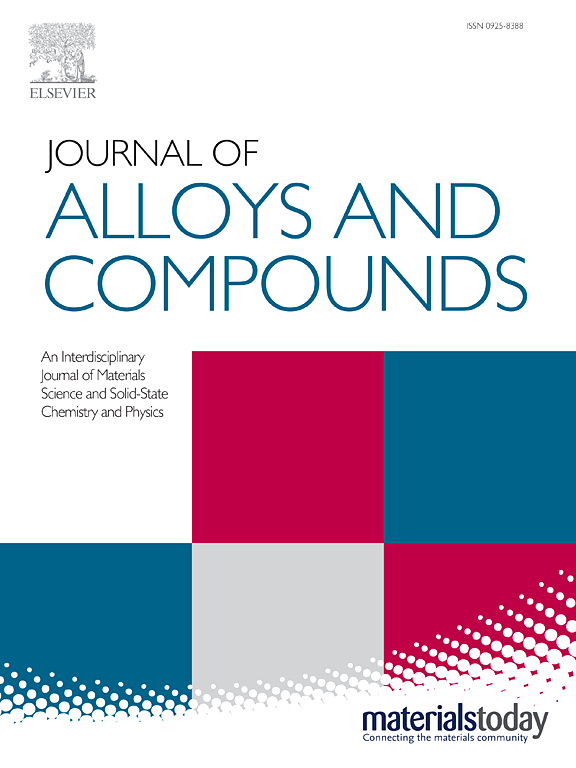激光冲击动态压实随机分布Al-Cu纳米粉体的性能研究
IF 5.8
2区 材料科学
Q2 CHEMISTRY, PHYSICAL
引用次数: 0
摘要
为了解决激光冲击下真实分布的纳米粉末的动态压实所面临的独特挑战,这不同于规则排列的粉末的压实过程。研究了随机分布的纳米Al-Cu粉末的激光冲击动态压实(LSDC)行为。目的是研究随机分布的纳米Al-Cu粉末在LSDC过程中的微观组织演变和致密化过程,并评估不同纳米Cu含量对Al-Cu纳米粉末致密物密度和力学性能的影响。采用自行研制的LSDC平台,将纳米铝粉和纳米铜粉以5 %、10 %和15 %的质量比均匀混合,制得密度为95.36 %的压块。通过Gurney能量方程建立了激光能量与上冲孔速度之间的关系模型,模拟了不同速度下纳米粉体的压实响应。使用Atomsk和LAMMPS软件构建的分子动力学(MD)模型紧密地代表了实际条件,可以表征激光冲击压实过程中的晶体结构变化、位错演化和其他行为。结果表明,随着纳米Cu含量的增加,Al-Cu合金的显微硬度逐渐降低。在500到1500 m/s的冲击速度范围内,材料表现出三个阶段:固体非致密化、固体致密化和液体致密化。该研究量化了激光冲击过程中的温度分布和位错密度,阐明了不同冲击速度下的压实机制。这些发现揭示了激光动态压实随机分布纳米Al-Cu粉末的微观结构演变、温度分布和致密化过程,为激光动态压实技术在纳米材料开发中的应用提供了理论支持。本文章由计算机程序翻译,如有差异,请以英文原文为准。

Study on the behavior of randomly distributed Al-Cu nanopowders by laser shock dynamic compaction
To address the unique challenges presented by the dynamic compaction of realistically distributed nanopowders under laser shock, which differs from the compaction process of regularly arranged powders. A study investigates the laser shock dynamic compaction (LSDC) behavior of randomly distributed nano Al-Cu powders. The aim was to investigate the microstructural evolution and densification of randomly distributed nano Al-Cu powders during LSDC and to assess the effect of varying nano Cu content on the density and mechanical properties of Al-Cu nanopowder compacts. Using a self-developed LSDC platform, nano aluminum and nano copper powders were uniformly mixed in mass ratios of 5 %, 10 %, and 15 %, producing compacts with a density of 95.36 %. A model was established via the Gurney energy equation to link laser energy to upper punch velocity, and the compaction response of the nanopowders at different velocities was simulated. Molecular dynamics (MD) modeling, constructed using Atomsk and LAMMPS software, closely represented actual conditions, allowing characterization of crystal structure changes, dislocation evolution, and other behaviors during laser shock compaction. Results indicated that increasing nano Cu content led to a gradual decrease in the microhardness of Al-Cu compacts. Across shock velocities from 500 to 1500 m/s, the material exhibited three stages: solid non-densification, solid densification, and liquid densification. The study quantified temperature distribution and dislocation density during laser shock, clarifying compaction mechanisms at various shock velocities. These findings reveal the microstructural evolution, temperature distribution, and densification processes in the laser dynamic compaction of randomly distributed nano Al-Cu powders, providing theoretical support for LSDC technology applications in nanomaterial development.
求助全文
通过发布文献求助,成功后即可免费获取论文全文。
去求助
来源期刊

Journal of Alloys and Compounds
工程技术-材料科学:综合
CiteScore
11.10
自引率
14.50%
发文量
5146
审稿时长
67 days
期刊介绍:
The Journal of Alloys and Compounds is intended to serve as an international medium for the publication of work on solid materials comprising compounds as well as alloys. Its great strength lies in the diversity of discipline which it encompasses, drawing together results from materials science, solid-state chemistry and physics.
 求助内容:
求助内容: 应助结果提醒方式:
应助结果提醒方式:


